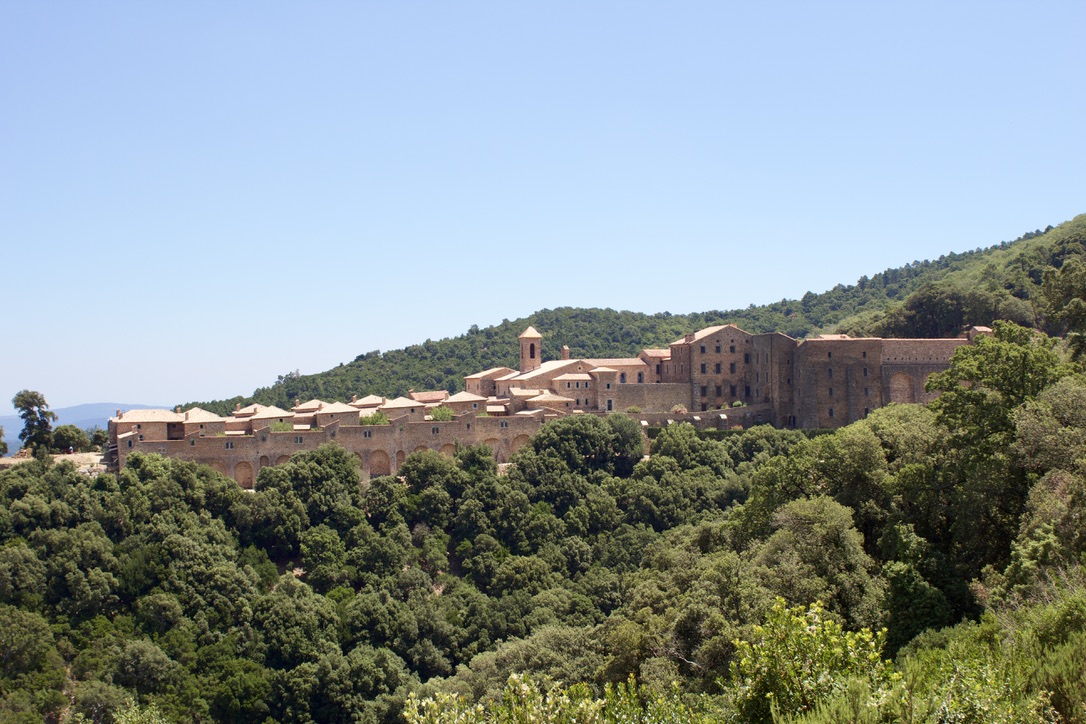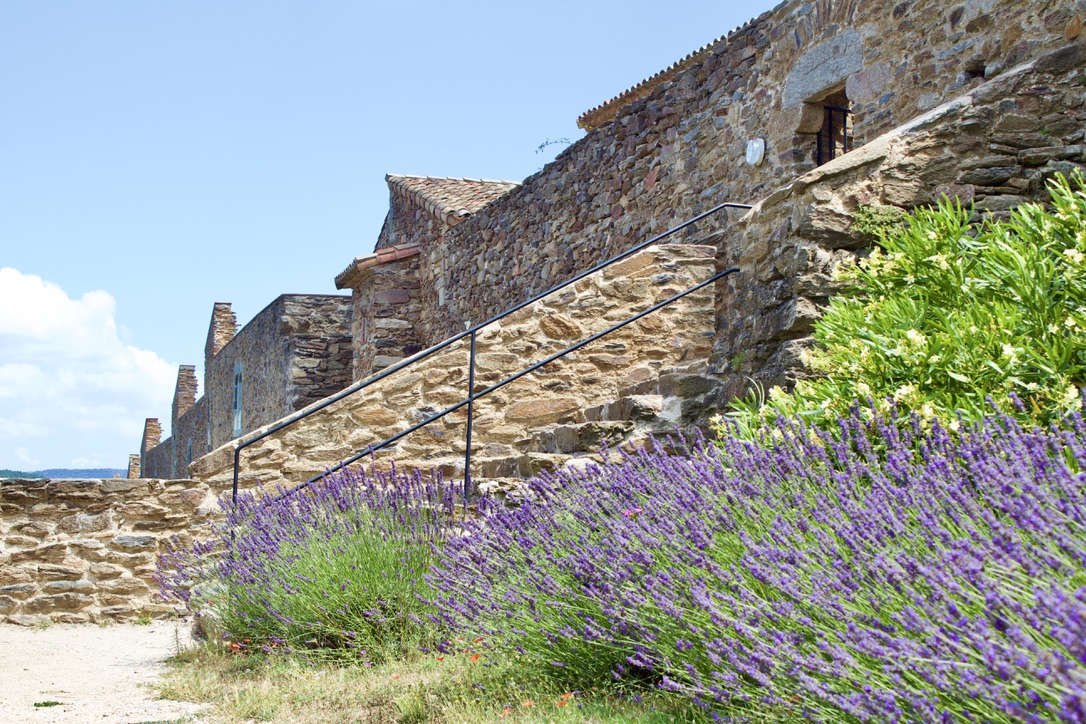CHARTREUSE DE LA VERNE - CHARTERHOUSE AT COLLOBRIÈRE
Located in the heart of the Massif des Maures, in the municipality of Collobrière in the Var department, the Chartreuse de la Verne was designated as a Historical Monument in 1921 and 1976.

HISTORY OF CHARTERHOUSE
Founded in 1170 AD by the presiding bishops of Fréjus and Toulon, the “Chartreuse de la Verne”, the home of Carthusian order, was originally known as the “Monastery of the Virgin Mary”. It has been governed under the authority of successive local priors: Didier, bishop of Toulon, first prior, Stephen, another bishop of Toulon, Bertrand de Correns, and later Joseph-Claude Geoffroy.

The first Roman Catholic church was consecrated in “Chartreuse de la Verne” on October 3, 1174. Destroyed by fire and rebuilt thereafter, it was sacked in 1416 by the lords of Bormes.
Following the great fires of the 13th and 14th centuries, all buildings except the church were destroyed and were rebuilt in the 17th and 18th centuries.
There are only a few surviving structures from the Romanesque period, including, the north wall of the church and part of its apse (a part of a church that is shaped like a half circle and usually located on the east side of a building).
The original bell from the 17th century tower was placed on a pedestal in the large entrance hall of the Town Hall of Collobrières.
In 1968, the complex was largely restored by using the stones found within surrounding ruins.
MONASTIC LIFE OF CHARTERHOUSE
The founding of the "Chartreuse de la Verne" came to pass in 1170, when the local bishop decided to install one of the groups of the Carthusian Order at the site.
A request was sent to the closest Charterhouse, "Chartreuse of Montrieux", located at Méounes-les-Montrieux, about 40 km from Collobrière between Toulon and Brignoles and 30 kilometers from Hyéres.
The history, customs, and life of the Charterhouse were directly related to those of their antecedents, the monastery of the Grande Chartreuse, located in Isère. The Carthusian Order was formed within the Roman Catholic church during the 11th century, with a unique emphasis on Carthusian monastic values and traditions.
The spiritual life of the Carthusians placed a premium on the virtues of silence and solitude. Carthusian monks were perpetually aspiring for absolute and total dedication to God. Individual monks pursued their spiritual goals within the confines of their individual living quarters (cells).
Nevertheless, the "Chartreuse de la Verne" held the status more or less of a Convent rather than a Monastery. The Carthusians, lay brothers living in Chartreuse, could interact with the outside world, something that was not permitted for monks. Such individuals were permitted to interact with the laborers who lived among them within the community and took care of the "hard" work such as farming crops, minding livestock, and related social activities.
"Chartreuse de la Verne" maintained a monastic life until the Carthusians were forced to relocate to Italy, following the onset of the French Revolution.
Since 1983 the monastery has regained its quasi-monastic tradition: it is now home to a community of nuns from Bethlehem. Hierarchically, the Charterhouse of Verne (Chartreuse de la Verne) is under the governance of the Charterhouse of Montrieux (Chartreuse de Montrieux).
ECONOMIC LIFE IN CHARTERHOUSE
The spiritual life of the Carthusian monks was devoted primarily to God, hence their devotion to the deity left the members of the community little time to exploit the large surrounding agricultural tracts. However, the community did benefit greatly from lands and forests in the region. Between 1084 and 1170, for example, the main population of the Carthusian order derived its wealth from forges operating in the Grenoble region. By the end of the 19th century, their revenues came mainly from the sale of a liquor named the "Chartreuse." Today visitors and tourists can purchase at Charterhouse various products made entirely by hand within the Chartreuse community such as ceramic tableware, wooden sculptures, pottery, and other objects related to religious procedures.
For visits, the Chartreuse is open:
- 11:00am-5:00pm, every day, except Tuesday, September thru December and February thru May;
- 11:00am-6:00pm June thru August.
Address: 83610 Collobrières, road D214
Phone: +33 4 94 43 48 28
FINE DINING NEARBY RESTAURANT LA COLOMBE
The restaurant "La Colombe" specializes in Provencal gourmet and traditional French cuisine.
The «Maitre Restaurateur» Pascal Bonamy welcomes you in a stylish environment of pastel colors and offers Provencale cuisine rich in Mediterranean fragrances.
This gourmet restaurant is higly praised and mentioned by Gault Millau, Bottin Gourmand, Champérard, and honored with a culinary prize by Quartet Veuve Clicquot.
Address: Bayorre - Route Nationale 98, 83400 Hyères
WINE TASTING
Provencal wines by « Château les Valentines »
Located 25 km from Chartreuse de la Verne, at La Londe-les-Maures, "Château Valentines" offers Provencal wines certified as belonging to the appellation Côte de Provence and Côte de Provence La Londe.
These wines are produced from grape varietals traditionally grown in Provence: the Cinsault, Grenache, Syrah, Mourvèdre, Cabernet Sauvignon, Rolle, Clarette, and Ugni-Blanc from vines more than of thirty years old. The varied range of wines are marketed as part of a line of gastronomic wines, "Great cuvee No. 8", great gourmet reds, "Caprice of Clementine" and sparkling rosé extra dry wine.
The range of gastronomic wines "Château les Valentines" are typical in character of those commonly associated with the appellation Cotes de Provence.
The "Great cuvee No. 8" family of wines reflect the exceptional characteristics of the land from which they are produced in the best winemaking traditions of the Côtes Provence La Londe appellation. The rosés possess mineral accents, full-bodied and ample. Made from old Ugni-Blanc, Clairette and Vermentine and aged in barrels, the white wines are fine and possess a delicate aromatic balance.
This collection of great gourmet reds offers wines of character, powerful and fine at the same time, with aromas of red and black fruits. Such reds are characterized by spicy cassis-like aromas.
The "Caprice of Clementine" range, for example, possesses flavors of fresh fruits in a delicate and delightful way, giving the rise to exceptional vintages. Rosé wines, on the other hand, are marked by the aromas of fine red fruits and spices. The white wines, in contrast, express the finesse of the Rolle, Clarets, and Ugni-Blanc varietals blended in a manner that provides hints of citrus accompanied by notes of iodine.
Among the wines tasted and described here, two proved especially noteworthy: the white wine "Caprice Clementine" and rosé sparkling wine extra brut. Produced from Ugni-Blanc, Clairette and Vermentine, the white wine is essence of finesse and delicate aromas. The rosé sparkling wine extra brut expresses the fine gourmand notes of citrus, wood strawberries and anise. Elaborated through traditional Provencal methods, this wine possesses fine, light bubbles, and a delightful effervescence.
The cellar is open from 9:00 am to 7:00 pm every day except Sunday and holidays.
Address: route de Collobrières, lieu-dit les Jassons, 83250 La Londe-les-Maures



